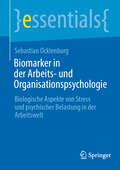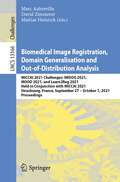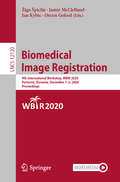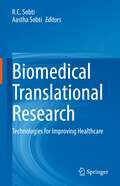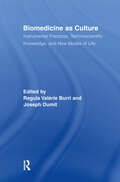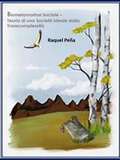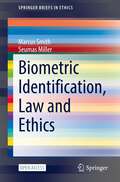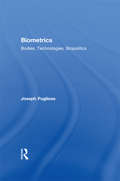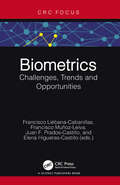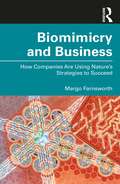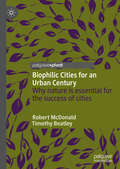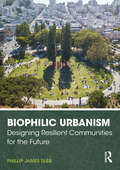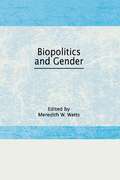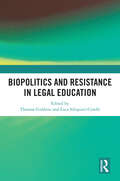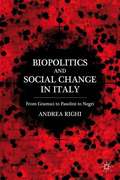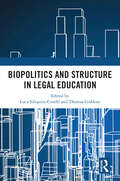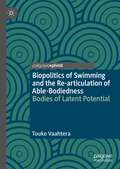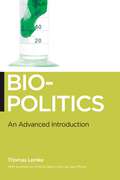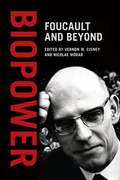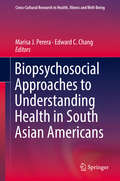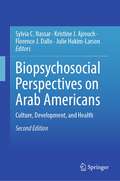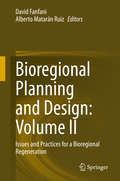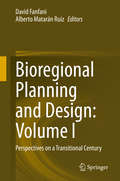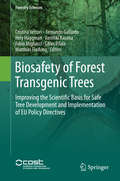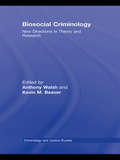- Table View
- List View
Biomarker in der Arbeits- und Organisationspsychologie: Biologische Aspekte von Stress und psychischer Belastung in der Arbeitswelt (essentials)
by Sebastian OcklenburgDieses essential gibt einen Überblick über Biomarker-Forschung in der Arbeits- und Organisationspsychologie. Dabei werden die zentralen Biomarker und Methoden zur Erfassung von Biomarkern erläutert. Der Autor beleuchtet spezifisch relevante Biomarker für psychische Erkrankungen im Kontext der Arbeitswelt sowie Biomarker für psychische Belastungsfolgen der Arbeit wie Burn-out. Das essential endet mit einer praxisorientierten Erläuterung organisationaler und finanzieller Aspekte von biopsychologischer Forschung in der Arbeitswelt.
Biomedical Image Registration, Domain Generalisation and Out-of-Distribution Analysis: MICCAI 2021 Challenges: MIDOG 2021, MOOD 2021, and Learn2Reg 2021, Held in Conjunction with MICCAI 2021, Strasbourg, France, September 27–October 1, 2021, Proceedings (Lecture Notes in Computer Science #13166)
by Marc Aubreville David Zimmerer Mattias HeinrichThis book constitutes three challenges that were held in conjunction with the 24th International Conference on Medical Image Computing and Computer-Assisted Intervention, MICCAI 2021, which was planned to take place in Strasbourg, France but changed to an online event due to the COVID-19 pandemic. The peer-reviewed 18 long and 9 short papers included in this volume stem from the following three biomedical image analysis challenges: Mitosis Domain Generalization Challenge (MIDOG 2021), Medical Out-of-Distribution Analysis Challenge (MOOD 2021), and Learn2Reg (L2R 2021). The challenges share the need for developing and fairly evaluating algorithms that increase accuracy, reproducibility and efficiency of automated image analysis in clinically relevant applications.
Biomedical Image Registration: 9th International Workshop, WBIR 2020, Portorož, Slovenia, December 1–2, 2020, Proceedings (Lecture Notes in Computer Science #12120)
by Orcun Goksel Žiga Špiclin Jamie McClelland Jan KybicThis book constitutes the refereed proceedings of the 9th International Workshop on Biomedical Image Registration, WBIR 2020, which was supposed to be held in Portorož, Slovenia, in June 2020. The conference was postponed until December 2020 due to the COVID-19 pandemic. The 16 full and poster papers included in this volume were carefully reviewed and selected from 22 submitted papers. The papers are organized in the following topical sections: Registration initialization and acceleration, interventional registration, landmark based registration, multi-channel registration, and sliding motion.
Biomedical Translational Research: Technologies for Improving Healthcare
by R. C. Sobti Aastha SobtiThis book, which is the first volume of Biomedical Translational Research, summarizes emerging technologies in healthcare. The book reviews the advancements in biomedical sciences in genomics, immunology, stem cell, tissue engineering, nanotechnology, computational and structural biology, biomedical engineering, and telemedicine biology. The book highlights the applications of artificial intelligence in the diagnosis of infectious diseases and examines the role of system biology approaches for understanding human complexity, variability, and its influence on health and diseases. It presents the applications of flow cytometry in monitoring the progression and treatment of disease. It covers emerging technologies in cancer research, including CRISPR-Cas9, NGS, and nanotechnology. This book is a useful source of information for clinical researchers, basic scientists, biomedical engineers, and computational biologists.
Biomedicine as Culture: Instrumental Practices, Technoscientific Knowledge, and New Modes of Life (Routledge Studies in Science, Technology and Society)
by Joseph Dumit Regula Valérie BurriThis volume offers interdisciplinary perspectives on contemporary biomedicine as a cultural practice. It brings together leading scholars from cultural anthropology, sociology, history, and science studies to conduct a critical dialogue on the culture(s) of biomedical practice, discussing its epistemic, material, and social implications. The essays look at the ways new biomedical knowledge is constructed within hospitals and academic settings and at how this knowledge changes perceptions, material arrangements, and social relations, not only within clinics and scientific communities, but especially once it is diffused into a broader cultural context.
Biometamorfosi Sociale: Teoria di una società ideale dalla transcomplessità
by Raquel PeñaBiometamorfosi sociale di Raquel Peña. Teoria di una società ideale dalla transcomplessità. Siamo tutti capaci di trasformarci. Siamo tutti capaci di trasformarci. La società richiede che gli individui che la compongono prendano coscienza dell'importanza di essere persone migliori, sotto una concezione etica, morale e spirituale. Questo libro mostra i risultati di un'indagine condotta in un settore popolare venezuelano dalla percezione degli attori sociali e come la conoscenza che possiedono come fonte generatrice emerga dalle loro esperienze. È da questa ricerca che è nata la teoria: Biometamorfosi Sociale.
Biometric Identification, Law and Ethics (SpringerBriefs in Ethics)
by Seumas Miller Marcus SmithThis book is open access. This book undertakes a multifaceted and integrated examination of biometric identification, including the current state of the technology, how it is being used, the key ethical issues, and the implications for law and regulation. The five chapters examine the main forms of contemporary biometrics–fingerprint recognition, facial recognition and DNA identification– as well the integration of biometric data with other forms of personal data, analyses key ethical concepts in play, including privacy, individual autonomy, collective responsibility, and joint ownership rights, and proposes a raft of principles to guide the regulation of biometrics in liberal democracies.Biometric identification technology is developing rapidly and being implemented more widely, along with other forms of information technology. As products, services and communication moves online, digital identity and security is becoming more important. Biometric identification facilitates this transition. Citizens now use biometrics to access a smartphone or obtain a passport; law enforcement agencies use biometrics in association with CCTV to identify a terrorist in a crowd, or identify a suspect via their fingerprints or DNA; and companies use biometrics to identify their customers and employees. In some cases the use of biometrics is governed by law, in others the technology has developed and been implemented so quickly that, perhaps because it has been viewed as a valuable security enhancement, laws regulating its use have often not been updated to reflect new applications. However, the technology associated with biometrics raises significant ethical problems, including in relation to individual privacy, ownership of biometric data, dual use and, more generally, as is illustrated by the increasing use of biometrics in authoritarian states such as China, the potential for unregulated biometrics to undermine fundamental principles of liberal democracy. Resolving these ethical problems is a vital step towards more effective regulation.
Biometrics: Bodies, Technologies, Biopolitics (Routledge Studies in Science, Technology and Society)
by Joseph PuglieseBiometric technologies, such as finger- or facial-scan, are being deployed across a variety of social contexts in order to facilitate and guarantee identity verification and authentication. In the post-9/11 world, biometric technologies have experienced an extraordinary period of growth as concerns about security and screening have increased. This book analyses biometric systems in terms of the application of biopolitical power – corporate, military and governmental – on the human body. It deploys cultural theory in examining the manner in which biometric technologies constitute the body as a target of surveillance and as a data-information object. The book thereby provides a comprehensive overview and critical analysis of both the local and global ramifications of biometric technologies.
Biometrics: Challenges, Trends and Opportunities
by Elena Higueras-Castillo Francisco Liébana-Cabanillas Francisco Muñoz-Leiva Juan F. Prados-CastilloThe book provides a comprehensive overview of biometrics, including its theoretical foundations and practical applications, and offers valuable insights into its relevance and impact on various sectors of society. It provides readers with a comprehensive view of how biometrics can shape future solutions that are secure, user focused, and technologically advanced. The first part discusses the fundamentals and applications of biometric technology. The second part discusses the challenges and future of biometric technologies.
Biomimicry and Business: How Companies Are Using Nature's Strategies to Succeed
by Margo FarnsworthBiomimicry, the practice of observing then mimicking nature’s strategies to solve business challenges, offers a path to healthy profit while working in partnership, and even reciprocity, with the natural world. Other books have described biomimicry, its uses, and its benefits. This book shows readers how to create their own biomimetic or bioinspired solutions with clear benefits to the bottom line, the environment, and people. Fashioned through storytelling, this book blends snapshots of five successful companies – Nike, Interface, Inc., PAX Scientific, Sharklet Technologies, and Encycle – which decided to partner with nature by deploying biomimicry. The book details how they discovered the practices, introduced them to staff, engaged in the process, and measured outcomes. The book concludes with challenges for readers to determine their own next steps in business and offers practical and useful resources to get there. By revealing the stories of each professional’s journey with lessons they learned, then providing resources and issuing a challenge and pathway to do business better, this book serves as a tool for entrepreneurs, seasoned professionals, and students to emulate nature’s brilliance, apply it at work, and contribute to a healthier, more prosperous world.
Biophilic Cities for an Urban Century: Why nature is essential for the success of cities
by Timothy Beatley Robert McDonaldThis book argues that, paradoxically, at their moment of triumph and fastest growth, cities need nature more than ever. Only if our urban world is full of biophilic cities will the coming urban century truly succeed. Cities are quintessentially human, the perfect forum for interaction, and we are entering what could justly be called the urban century, the fastest period of urban growth in human history. Yet a growing body of scientific literature shows that the constant interaction, the hyper-connectedness, of cities leads to an urban psychological penalty. Nature in cities can be solution to this dilemma, allowing us to have all the benefits of our urban, connected world yet also have that urban home be a place where humanity can thrive. This book presents best practices and case studies from biophilic design, showing how cities around the world are beginning to incorporate nature into their urban fabric. It will be a valuable resource for scholars and professionals working in the area of sustainable cities.
Biophilic Urbanism: Designing Resilient Communities for the Future
by Phillip James TabbBiophilic Urbanism provides readers with the tools to create more nature-based urban environments that are climate positive, sustainable, and healthy. The principles of biophilia are intended to support appreciation and direct engagement with nature, to responsibly utilize on-site natural resources, and to plan according to climatic conditions and local ecological processes. It seeks to create resilient and equitable human places capable of providing critical life-support functions and a strong sense of community, and to foster experiences that raise the human spirit creating a sense of awe. Twenty-five pattern attributes are defined and explored, each of which contributes to these goals. Because of the dire necessity to respond to the COVID-19 pandemic, Biophilic Urbanism includes discussion of our need for connections, both to nature and one another, and the physical characteristics of cities and buildings relative to the contagious qualities of the air-borne virus. Case studies, found throughout the world, are presented illustrating detailed biophilic planning and design strategies. The book will be of use to practitioners and students in the fields of natural and social sciences, behavioral science and psychology, environmental engineering, health and wellness professionals, architecture, landscape architecture, interior architecture, and planning.
Biopolitics and Gender
by Meredith W Watts JrHere is an important book for social scientists interested in the influence of gender on certain types of behavior. Several perspectives are presented on the general topic of biopolitics and gender, including the points of view of brain science, endocrinology, ethology, psychophysiology, and such conventional interests as political attitudes, socialization, participation, social structure, and political hierarchy. The varied and provocative ideas explored in this volume will broaden discussions of gender beyond an exclusive focus on sex links to oppression and discrimination.
Biopolitics and Resistance in Legal Education
by Thomas Giddens and Luca Siliquini-CinelliTaking up the study of legal education in distinctly biopolitical terms, this book provides a critical and political analysis of resistance in the law school. Legal education concerns the complex pathways by which an individual becomes a lawyer, making the journey from lay-person to expert, from student to practitioner. To pose the idea of a biopolitics of legal education is not only to recognise the tensions surrounding this journey but also to recognise that legal education is a key site in which the subject engages, and is engaged by, a particular structure—and here the particular structure of the law school. This book explores the resistance to that structure, including: different ways in which law’s pedagogic structures might be incomplete, or are being fought against; the use of less conventional elements of cultural discourse to resist the abstraction of the lawyer in students’ subject formation; the centralisation of queer and feminist discourses to disrupt the hierarchies of the legal curriculum; the use of digital technologies; the place of embodiment in legal education settings; and the impacts of posthuman knowledges and contexts on legal learning. Assembling original, field-defining essays by both leading international scholars and emerging researchers, this book constitutes an indispensable resource in legal education research and scholarship that will appeal to legal academics everywhere.
Biopolitics and Social Change in Italy
by Andrea RighiThe study of how life can be controlled, supported, and manipulated has become the most urgent scientific and political task of our society. By placing the social dimension of labor at the base of the discourse of life, this book engages with the work of key intellectual figures including Gramsci, Pasolini, the neo-feminist militants of Lotta Femminista, Negri, and Virno, and reconstructs a critical genealogy of the notion of biopolitics from the point of view of twentieth and twenty-first century Italy. "
Biopolitics and Structure in Legal Education
by Luca Siliquini-Cinelli and Thomas GiddensTaking up the study of legal education in distinctly biopolitical terms, this book provides a critical and political analysis of structure in the law school. Legal education concerns the complex pathways by which an individual becomes a lawyer, making the journey from lay-person to expert, from student to practitioner. To pose the idea of a biopolitics of legal education is not only to recognise the tensions surrounding this journey, but also to recognise that legal education is a key site in which the subject engages, and is engaged by, a particular structure—and here the particular structure of the law school. This book explores that structure by addressing the characteristics of the biopolitical orders engaged in legal education, including: understanding the lawyer as a commodity, unpicking the force relations in legal education, examining the ways codes of conduct in higher education impact academic freedom, as well as putting the distinctly Western structures of legal learning within a wider context. Assembling original, field-defining essays by both leading international scholars and emerging researchers, it constitutes an indispensable resource in legal education research and scholarship that will appeal to legal academics everywhere.
Biopolitics of Swimming and the Re-articulation of Able-Bodiedness: Bodies of Latent Potential
by Touko VaahteraIn this book, Touko Vaahtera explores how “bodies of latent potential,” a cultural attachment to the idea of body as potentiality, carries with it hierarchizing hopes about better bodies. Vaahtera combines disability studies, cultural studies, feminist science studies, transgender studies, post-colonial studies, and Foucauldian genealogy to offer a provocative approach that interrogates capacities and capabilities as obvious frameworks for thinking about the body. Vaahtera explores how swimming skills emerged as a specific biopolitical question in Finland, a country that has been described as the “Land of a Thousand Lakes.” Through a profound cultural analysis focusing both on Finnish cultural texts on swimming as well as manifold more globalized texts, Vaahtera considers how the legacy of eugenics and colonialism, the hopes of civilization, and homogenizing assumptions about bodies frame how we think about human capacity.
Biopolitics: An Advanced Introduction (Biopolitics #5)
by Thomas LemkeThe first systematic overview of the notion of biopolitics and its relevance in contemporary theoretical debateThe biological features of human beings are now measured, observed, and understood in ways never before thought possible, defining norms, establishing standards, and determining average values of human life. While the notion of “biopolitics” has been linked to everything from rational decision-making and the democratic organization of social life to eugenics and racism, Thomas Lemke offers the very first systematic overview of the history of the notion of biopolitics, exploring its relevance in contemporary theoretical debates and providing a much needed primer on the topic. Lemke explains that life has become an independent, objective and measurable factor as well as a collective reality that can be separated from concrete living beings and the singularity of individual experience. He shows how our understanding of the processes of life, the organizing of populations and the need to “govern” individuals and collectives lead to practices of correction, exclusion, normalization, and disciplining. In this lucidly written book, Lemke outlines the stakes and the debates surrounding biopolitics, providing a systematic overview of the history of the notion and making clear its relevance for sociological and contemporary theoretical debates.
Biopower
by Vernon W. Cisney Nicolae MorarMichel Foucault's notion of "biopower" has been a highly fertile concept in recent theory, influencing thinkers worldwide across a variety of disciplines and concerns. In The History of Sexuality: An Introduction, Foucault famously employed the term to describe "a power bent on generating forces, making them grow, and ordering them, rather than one dedicated to impeding them, making them submit, or destroying them." With this volume, Vernon W. Cisney and Nicolae Morar bring together leading contemporary scholars to explore the many theoretical possibilities that the concept of biopower has enabled while at the same time pinpointing their most important shared resonances. Situating biopower as a radical alternative to traditional conceptions of power--what Foucault called "sovereign power"--the contributors examine a host of matters centered on life, the body, and the subject as a living citizen. Altogether, they pay testament to the lasting relevance of biopower in some of our most important contemporary debates on issues ranging from health care rights to immigration laws, HIV prevention discourse, genomics medicine, and many other topics.
Biopsychosocial Approaches to Understanding Health in South Asian Americans (Cross-Cultural Research in Health, Illness and Well-Being)
by Marisa J. Perera Edward C. ChangThis volume is the first comprehensive and interdisciplinary text to holistically improve understanding of the health of South Asians residing in the United States by considering biological, psychological, and sociocultural factors of health. The vast literatures of diverse fields – psychology, medicine, public health, social work, and health policy – are integrated by leading scholars, scientists, and practitioners in these areas to explore the impact of South Asian cultural factors on health, health risk, and illness. Chapters incorporate available theoretical and empirical information on the status of chronic health conditions in South Asians in the United States, with consideration of future directions to improve understanding of the health of this group. Cultural and ethnic insights imperative for clinical/community/medical practitioners to provide effective and culturally-appropriate care and treatment from an interdisciplinary lens are provided.
Biopsychosocial Perspectives on Arab Americans: Culture, Development, and Health
by Kristine J. Ajrouch Julie Hakim-Larson Sylvia C. Nassar Florence J. DalloThe biopsychosocial study of Arab Americans yields compelling insights into innovative theoretical and applied initiatives. In the context of a growing population of Arab Americans, coupled with the current tenure of xenophobia and exposed structural racism in the US, clinical and community practitioners must be attuned to their clients of Arab ancestry, whose experiences, development, and health concerns are distinctly different than that of their White counterparts. This second edition, with its uniquely interwoven sections of culture, psychosocial development, and health and disease, provides a rich overview of timely, critical topics. The audience for the text includes counselors, social workers, psychologists, nurses, psychiatrists, sociologists, and any other public and mental health practitioners, researchers, and policy makers who work with and on behalf of clients and patients of Arab descent. The authors represent a team of leading experts spanning disciplines of sociology, clinical mental health, and community public health. "This edition draws on leading experts in Arab American health and sociology who document the complexity of this population's immigration and acculturation experience. It offers critical and current research that speaks to the centrality of context and diversity in treating Americans of Arab descent. Contributors explore the complex and limited racial framework within which Arabs in the U.S. form their identities, and the impact of structural racism on their lives and health. This collection offers practitioners much needed insights on a population often hidden or rendered invisible by data limitations, and yet misrepresented by cultural stereotypes." Helen Hatab Samhan, Former Executive Director, Arab American Institute/Foundation. "Nassar, Ajrouch, Hakim-Larson, and Dallo’s breakthrough work in the area of culturally competent health care has been inspiring across interdisciplinary fields and to the communities they serve. Their work on Arab American health issues, in particular, has greatly improved clinical practice at the community and national levels. I heartily recommend taking the time to become familiar with their important body of work and this latest text."Ismael Ahmed, Former Michigan State Director of Health and Human Services.
Bioregional Planning and Design: Issues and Practices for a Bioregional Regeneration
by David Fanfani Alberto Matarán RuizThis book provides insights and discusses the practical application of the theoretical concept of urban bioregion complementing the general bio-regional planning cross-disciplinary issues provided in Volume I. It examines planning practices, such as relocalisation of energy flows, land protection for climate change, territorial heritage enhancement, the consideration of urban ecosystems and agro-ecology. It presents discussions on regional contexts, practices and projects for a bioregional recovery, and includes case studies from France, Belgium, Spain, Greece, Austria and Italy, discussing topics that range from the reframing of local energy production/delivery planning systems to soil protection and farmland sustainable exploitation schemes. This volume concludes with three cross-European case studies that make clear the worldwide relevance and potential of bioregional approach beyond the Global North or Western countries.
Bioregional Planning and Design: Perspectives on a Transitional Century
by David Fanfani Alberto Matarán RuizThis book provides a review of the bioregionalist theory in the field of spatial planning and design as a suitable approach to cope with the growing concerns about the negative effects of metropolization processes and the need for a sustainable transition. The book starts out with a section on rethinking places for community life, and discusses the reframing of regional governance and development as well as social justice in spatial planning. It introduces the concept of the urban bioregion, a pivotal concept that underpins balanced polycentric spatial patterns and supports self-reliant and fair local development. The second part of the book focuses on planning, and particularly on the issues that arise from the ‘circular’ recovery of the relation between city and agro-ecosystems for integrated planning and resilience of settlements and discusses topics such as foodshed planning, biophilic urbanism and the integration of rural development and spatial planning. This volume sets out the reference framework for Volume II which deals with more specific and operational issues related to spatial policies and settlement design.
Biosafety of Forest Transgenic Trees: Improving the Scientific Basis for Safe Tree Development and Implementation of EU Policy Directives (Forestry Sciences #82)
by Cristina Vettori Fernando Gallardo Hely Häggman Vassiliki Kazana Fabio Migliacci Gilles Pilate Matthias FladungThis book provides up-to-date information on the environmental impact of transgenic trees on genetically modified tree (GMT) communication strategy. It is useful to public/private organisations as well as to private and public research bodies and universities worldwide since it reports on the global status of GMT research and policy. A high number of genetically modified trees (GMTs) with altered or novel characteristics have been produced in the last 15 years. However, their very low public acceptance is a basic problem in their commercialization. Breeders anticipate economic and ecological benefits, like reduced product costs and less pressure on native forests, while opponents fear risks, such as unintended spread of GMTs. But what is true? To answer this question, the COST Action FP0905 focused on key aspects related to GMTs: (a) biological characterization; (b) assessment of possible environmental impacts; (c) socio-economic implications and public acceptance/concerns; (d) providing science-based information to communicate with the public.
Biosocial Criminology: New Directions in Theory and Research (Criminology and Justice Studies)
by Anthony Walsh Kevin M. BeaverIdeal for use, either as a second text in a standard criminology course, or for a discrete course on biosocial perspectives, this book of original chapters breaks new and important ground for ways today's criminologists need to think more broadly about the crime problem.
